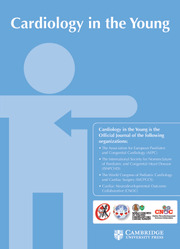No CrossRef data available.
Article contents
Profound systemic hypoperfusion in a patient with ventricular inversion temporised with transcatheter ductal closure
Published online by Cambridge University Press: 16 October 2025
Abstract
Isolated atrioventricular discordance with ventriculoarterial concordance, or ventricular inversion, is a rare congenital cardiac anomaly that produces transposition-like physiology. We report a case of prenatally diagnosed ventricular inversion presenting with profound systemic hypoperfusion secondary to a large patent ductus arteriosus (PDA). Initial management included prostaglandin E1 to maintain ductal patency and balloon atrial septostomy to promote intracardiac mixing. Despite these measures, the patient developed significant pulmonary overcirculation and systemic steal, necessitating urgent transcatheter PDA closure. This intervention resulted in immediate hemodynamic improvement and stabilization, allowing for subsequent definitive repair with VSD closure and Senning atrial switch. The case underscores the importance of individualized hemodynamic assessment and the potential for transcatheter ductal closure to temporize systemic perfusion in select patients with ventricular inversion prior to anatomic correction.
Keywords
Information
- Type
- Case Report
- Information
- Copyright
- © The Author(s), 2025. Published by Cambridge University Press


